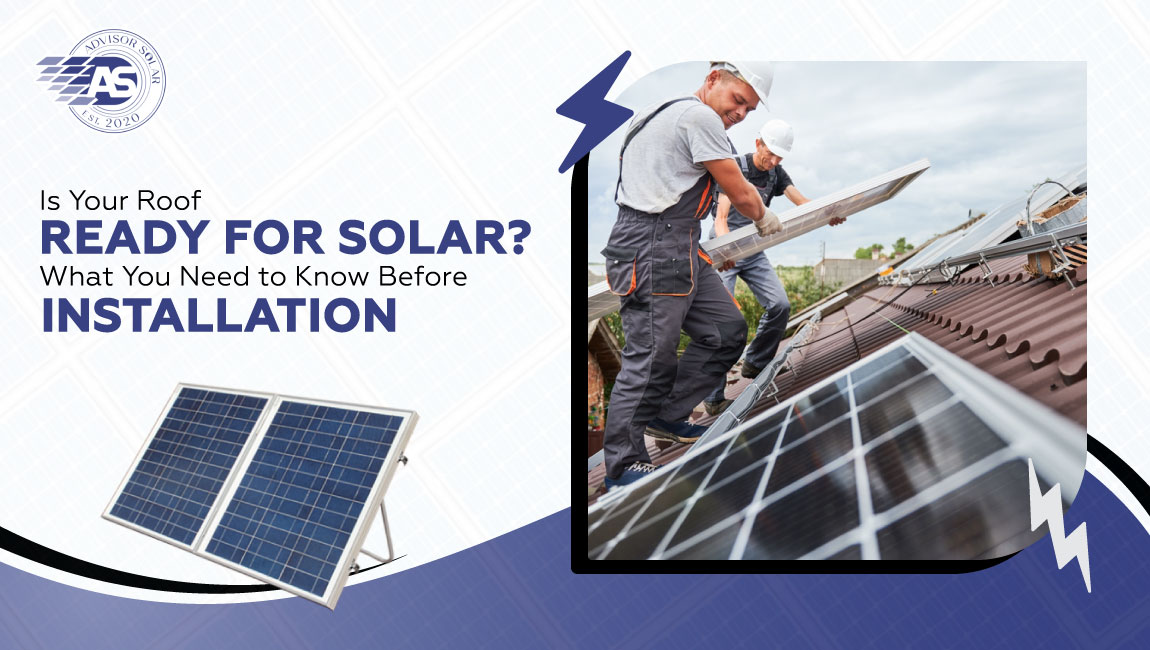Moving to solar energy is a progressive step in decreasing your carbon footprint and economizing on electricity bills. But before you start dreaming of those shiny panels on your rooftop, there is one fundamental question to be aimed at: Is your roof standard for a solar energy installation?
Here at Advisor Solar, it’s disappointing to note how often we hear about roof readiness being neglected, leading to additional costs and repair times that slow down the process.
This guide will also explain why roof preparation is necessary, how to determine whether your roof is suitable for solar, and what measures can be taken to guarantee efficient solar system installation on your roof.
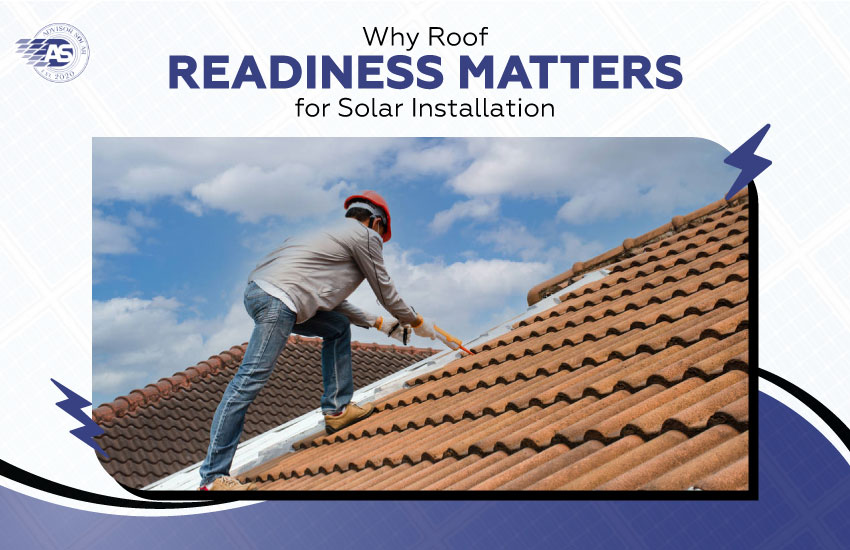
Why Roof Readiness Matters for Solar Installation
Your roof is not only a surface for mounting solar panels; it is the core of your solar power system. Therefore, if your roof is not in good condition, it will affect the efficiency and safety of the panels. Even more dangerously, a lack of readiness for the roof can result in additional problems. For example, the panels must be removed and reinstalled for roof repairs.
Solar panels are long-term investments, with a lifespan of approximately 25–30 years. Safeguarding that investment from the beginning ensures the roof is ready and reduces future concerns.
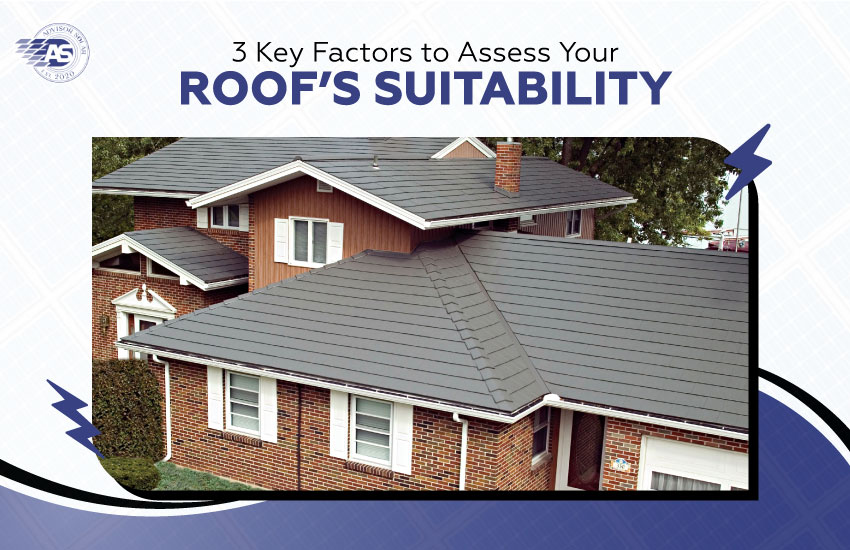
3 Key Factors to Assess Your Roof’s Suitability
Identifying your roof’s status is crucial to securing your solar journey.
Here are the top factors to evaluate:
- Roof Age and Condition
- Roof Orientation and Angle
- Shading and Obstructions
1. Roof Age and Condition
Solar installation can be complicated if the roof has reached the end of its lifespan or needs replacement. Since panels typically last for decades, your roof should be well-prepared before installation.
- Inspect for damage: Look for damaged roofs, water penetrations, or any distortion that could affect the roof’s ability to withstand solar systems.
- Evaluate lifespan: If your current roof is older and needs replacement soon (say, 15-20 years old for asphalt shingles), replacing it before installing solar panels is best.
- Schedule professional checks. A roofing expert can identify leaks or rotting that might have affected the building’s structure.
- Plan for long-term durability: If an electrical repair or wiring replacement is necessary, it is wiser to do it now rather than later, as you will have to remove the panels.
2. Roof Orientation and Angle
Roof orientation and tilt have a significant influence on solar power generation.
- South-facing roofs: These are exposed to more direct sunlight in most of the Northern Hemisphere and can extensively serve the purpose of energy production.
- Optimal angle: A roof with an angle between 15 and 45 degrees is ideal for installing solar systems.
- Flat roofs: Solar panels can still be installed, but in some cases, mounting systems might be required to adjust the angle and inclination.
- Consult solar experts: A professional can determine a roof layout that suits the light availability in your area.
3. Shading and Obstructions
Nearby shadows from other buildings or trees can compromise solar panel performance.
- Trim trees: Any limbs growing near your roof should be pruned or cut off if they hinder sunlight from getting to your roof.
- Eliminate unnecessary obstructions: Remove things that are no longer needed, such as an old satellite dish or antenna.
- Check seasonal patterns: Ensure your roof gets direct sunlight throughout the year, and consider when the sun’s angle will differ.
- Use solar mapping tools: There are resources such as Google’s innovative Project Sunroof that can assist in discovering shade locations.
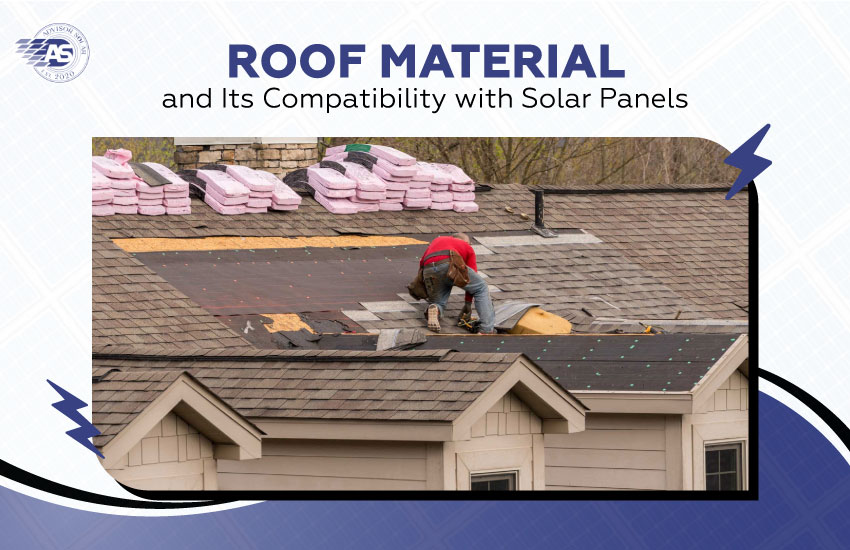
Roof Material and Its Compatibility with Solar Panels
Not all roof materials are suitable for solar panels. Although most kinds can support panels, installation procedures may differ.
- Asphalt shingles: These are the most common and easiest materials to work with in solar installation.
- Metal roofs: Standing seam metal roofs are appropriate because panel fastening doesn’t require drilling.
- Tile roofs: Tile roofs can be used with solar panels but with some caution due to the possible damage of tiles during installation.
- Flat roofs: These necessitate mounting systems to orient the panels at the correct angle of incidence.
If you have doubts about the compatibility of your roof material, it is recommended to seek advice from qualified solar installers such as Advisor Solar.

Structural Considerations for Solar Panels
Will your current roof structure be capable of withstanding the added weight of solar panels? Although most roofs should be able to handle the additional load, it is essential to look at the structural implications that can lead to safety hazards or cooperative performance setbacks.
Let’s explore the key factors:
- Weight Concerns
- Reinforcement Needs
- Weather Resistance
- Consult a Structural Engineer
1. Weight Concerns
Solar panels weigh between 2-4 pounds per square foot, including the mounting structure on the roof. In most cases, it is not a problem for most modern roofs because it is well within their load space capacity.
However:
- Older roofs: These might have been weakened structurally and could not bear extra load.
- Material differences: Installation may also pose a challenge, especially for roofing materials such as tile or slate, which might have been placed on the building in the first place because of their weight.
- Solar panels installed on homes can be expected to weigh about 40 pounds each, and in terms of weight per square foot, it is close to about 2.3 pounds. When mounting equipment, it ranges between 3 and 4 pounds per square foot of total weight. (Solar Reviews). Did you know? Additional loads as small as ten percent can stress roofs compromised by age or water damage.
2. Reinforcement Needs
If your roof structure has some pre-existing condition, support might be required.
- Add Framing for Load Distribution: To spread the loads on the panel properly.
- Reinforce Weak Areas: To be safe, reinforcements of weak areas should be worked on to make structures last long.
- Retrofitting for Aged Roofs: Residential structures with aged roofing systems may need retrofitting to support the new load drawn by solar PV installations. This could include installing more support beams or columns to the building frame. (Roof Leaks and Moore)
3. Weather Resistance
Can you stand heavy snow loads, violent winds, or severe rainfall on your roof? Solar panels are built in a way to handle these weather conditions. However, your roof needs to be well prepared for that as well.
4. Consult a Structural Engineer
Have an older home? A professional solar structure assessment by Advisor Solar can reveal these problems and make your solar roof conform and safe for decades.
Do you think that your roofing system is ready for the challenge? If not, it’s time to call in a professional for evaluation.
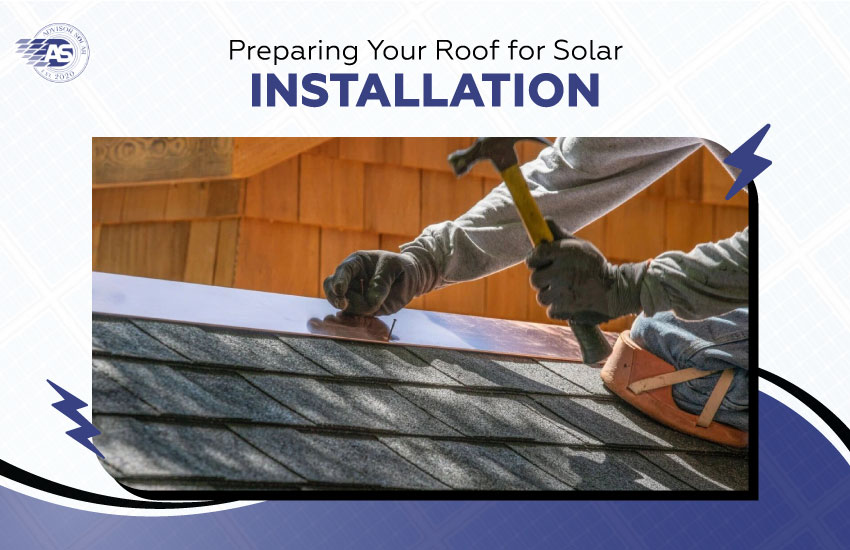
Preparing Your Roof for Solar Installation
Some of the following factors will help you ensure that roof installation is effective and your solar system will function effectively for several years. Proper roof preparation also helps reduce such risks and avoids many setbacks at later stages.
Here’s how to get ready:
- Clear Obstructions
- Inspect and Repair
- Ensure Accessibility
- Plan for Future Maintenance
1. Clear Obstructions
The branches of trees, old vents, or even satellite dishes may hinder light and pose a problem to the safety of the installers.
- Trim overhanging branches: Shadows created by trees on your roof can cause a decrease in the effectiveness of a solar panel. Prune branches increase the sun’s exposure to the foliage.
- Remove unused equipment: Any broken or unused antenna, vent, or satellite dish must be removed to ensure the panels can be mounted smoothly.
- Clear debris: Ensure the roof is clean of leaves, dirt, etc., which may hinder the installation or affect the panels’ performance.
2. Inspect and Repair
Minor fixes done before installation will eliminate significant problems in the future.
- Check for damage: look for cracked and missing shingles, water stains, or any other structural problem.
- Seal leaks: Even small damp spots or leaks must be addressed to safeguard your house and guarantee your roof is free from water penetration.
- Hire professionals: A roofing professional can discover issues that are hard to see, such as degraded beams or other structural problems that may affect the roof. Whether the roof needs reinforcement before the installation can be decided with the help of a structural engineer or a professional roofer. (Exactus Energy)
3. Ensure Accessibility
Ensuring that your roof is accessible will make the installation process more manageable and, at the same time, provide the worker’s security.
- Create clear pathways: Clear out anything that might get in the way of reaching the roof, including furniture, ladders, or storage items.
- Provide safe access points: Check a proper escape route available for anyone needing to access the roof for any reason, including installers.
- Secure the work area: Prevent mishaps by ensuring that the installation area is not accessible to pets or kids.
4. Plan for Future Maintenance
Solar panels need some level of maintenance occasionally to ensure they work optimally. Doing this now rather than later will be less time-consuming and less effortful.
- Add pathways: Create roof surfaces that can be walked across to reach panels mounted on rooftops for cleaning or repair occurrences.
- Install railings or safety features: It may also be beneficial to install protective railings that efficiently minimize the dangers for workers when maintaining.
- Consider long-term needs: If your roof is prone to frequent maintenance, discuss this with your solar installer to ensure there are access points for the system.
These preventions make the installation process less problematic and pave the way for efficient energy utilization for many years. At Advisor Solar, we are always there to ensure that we guide you through each stage until your roof is ready for the perfect installation of solar installations.

Get Advisor Solar’s Roofing Services to Ensure Roof Readiness
At Advisor Solar, the idea of roof readiness is crucial as it helps determine the viability of a roof for the installation of solar panels. We have developed specialized roofing services to meet all your needs. Whether it is inspection, maintenance, upgrades, or replacement, we manage every process on your behalf to ease your stress.
Our Roofing Services Include:
- Safe removal and storage: If you require roof replacement or repair, we will start by safely uninstalling and disassembling your solar panels.
- Thorough inspections: We will perform a comprehensive analysis of your roof to identify the challenges that may hinder the installation of solar panels.
- Reinstallation: Finally, when your roof is set, we will help you re-establish your solar system without any challenge.
- Coordination with contractors: We coordinate with roofing specialists to facilitate the process.
- Flexible financing options: Ensure you receive the services you require at an affordable rate.
Advisor Solar has completed over 2000 successful solar installations and has more than ten years of experience in the industry.
FAQs
Indeed, the panels can be removed and reinstalled; however, they have associated costs. To eliminate any additional cost, fixing or changing the roof thoroughly before the installation is advised.
On average, solar panels increase the roof’s weight by 2-4 pounds; thus, most modern roofs can withstand the increased weight. However, older roofs may need additional structural support.
It is not a good idea, but attaching solar panels to an old roof is still possible. If you think your roof is almost at the end of its lifespan, it is better to switch it out so that later on, you do not have to go through the hassle of taking off the panels for maintenance or multiple replacements.
Look for signs of wear on your roofing, such as cracks, stains, or any drooping sections. If you doubt the integrity of its condition, it is advisable to seek professional help in the assessment.

